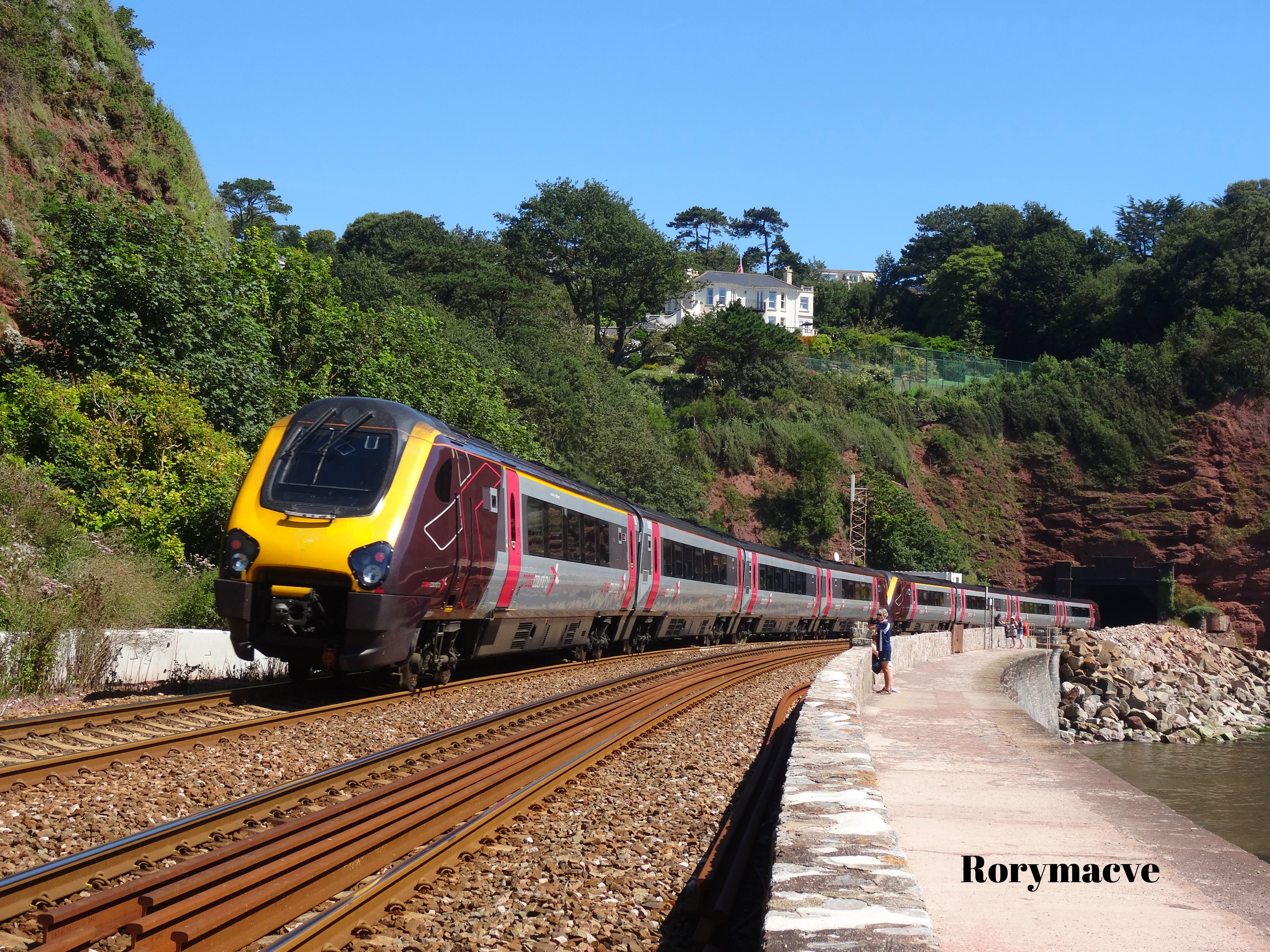ShopDreamUp AI ArtDreamUp
Deviation Actions

Royal Steam Fund
Support my continuous work by contributing to my tip jar. This tier won't include any specific perks, but you will receive my appreciation and a more regular upload schedule. Furthermore, your contribution will help me pay off a loan I had to take on for special medical treatment.
$5/month
Suggested Deviants
Suggested Collections
You Might Like…
Featured in Groups
Description
Speeding north from Teignmouth with the 1S49 Newquay to Dundee are a pair of Cross Country Class 220's.
The Class 220 and their tilting Class 221 brothers were built between 2000 and 2002 by Bombardier at their factory in Bruges, Belgium. The requirement of the Class 220/221 Voyager units was to help replace the ageing Class 47's on loco-hauled services and Class 43 HST sets across the Cross Country network. In total, 34 Class 220's and 44 Class 221's were ordered for an introduction in 2001.
The Class 220's and 221's are almost identical, but different in a variety of ways. Class 220's are distinguishable by their 4-car formations and much more stubby noses, whilst Class 221's are 5-car, have a much more streamlined shape and were built with Tilting Mechanisms on their bogeys to allow for tilting on the West Coast Mainline in similar fashion to that of the Class 390 Pendolino units. Both classes however are powered by Cummins QSK19 750hp diesel engines located under the floors of each carriage.
Introduction began in 2001 of both these units, the construction of the Class 220's being completed the same year, whilst the last Class 221's were delivered in mid-2002. However, immediate problems and concerns were raised as to the lower capacity of these units in relation to the HST's and Loco-hauled rakes they replaced. With 4 and 5 car formations, the units were, and still are, frequently full to capacity on the busiest section of the route between Bristol Temple Meads and Newcastle. Because of this, Loco-hauled operation remained for another year until 2002, whilst Class 43 HST sets remained in operation right until 2003, with sets still being hired in from Midland Mainline and GNER.
Operations of the Class 220's and 221's were separated under Virgin Trains between Cross Country operations from Plymouth and Penzance in the South West of England, to the Midlands, Edinburgh, Glasgow and Aberdeen in Scotland, and West Coast Mainline operations between London Euston, Crewe, Chester, Wrexham and Holyhead to replace the HST's, these operations being primarily operated by Class 221's and their tilting capabilities.
Other problems highlighted with the Class 220 and 221's was their roof-mounted equipment, which took a disliking to salt water, a problem that frequently occurs on the Dawlish and Teignmouth Sea Wall when the weather gets up. The result was a number of notable break downs during storms in 2005, 2006 and 2007, with trains having to limp into tunnels to protect them from the sea and await rescue.These problems have been fixed somewhat by software updates.
In November 2007, Virgin lost the Cross Country franchise to Arriva, and thus the Voyager fleet was split. All Class 220's were handed over to new operator Cross Country, whilst the Class 221 fleet was split between Virgin West Coast and the new operator. In total, Virgin retained 21 Class 221's, whilst Cross Country obtained 23. However, some of Virgin's sets comprised only of 4-cars, and thus Class 221, 221144, donated its intermediate trailers to help lengthen these sets to 5-cars, with this unit being placed into storage for driver and crew training. Arriva's Class 221's have since had their Tilting Mechanisms disabled as they have been considered surplus to requirement.
The Class 220 and their tilting Class 221 brothers were built between 2000 and 2002 by Bombardier at their factory in Bruges, Belgium. The requirement of the Class 220/221 Voyager units was to help replace the ageing Class 47's on loco-hauled services and Class 43 HST sets across the Cross Country network. In total, 34 Class 220's and 44 Class 221's were ordered for an introduction in 2001.
The Class 220's and 221's are almost identical, but different in a variety of ways. Class 220's are distinguishable by their 4-car formations and much more stubby noses, whilst Class 221's are 5-car, have a much more streamlined shape and were built with Tilting Mechanisms on their bogeys to allow for tilting on the West Coast Mainline in similar fashion to that of the Class 390 Pendolino units. Both classes however are powered by Cummins QSK19 750hp diesel engines located under the floors of each carriage.
Introduction began in 2001 of both these units, the construction of the Class 220's being completed the same year, whilst the last Class 221's were delivered in mid-2002. However, immediate problems and concerns were raised as to the lower capacity of these units in relation to the HST's and Loco-hauled rakes they replaced. With 4 and 5 car formations, the units were, and still are, frequently full to capacity on the busiest section of the route between Bristol Temple Meads and Newcastle. Because of this, Loco-hauled operation remained for another year until 2002, whilst Class 43 HST sets remained in operation right until 2003, with sets still being hired in from Midland Mainline and GNER.
Operations of the Class 220's and 221's were separated under Virgin Trains between Cross Country operations from Plymouth and Penzance in the South West of England, to the Midlands, Edinburgh, Glasgow and Aberdeen in Scotland, and West Coast Mainline operations between London Euston, Crewe, Chester, Wrexham and Holyhead to replace the HST's, these operations being primarily operated by Class 221's and their tilting capabilities.
Other problems highlighted with the Class 220 and 221's was their roof-mounted equipment, which took a disliking to salt water, a problem that frequently occurs on the Dawlish and Teignmouth Sea Wall when the weather gets up. The result was a number of notable break downs during storms in 2005, 2006 and 2007, with trains having to limp into tunnels to protect them from the sea and await rescue.These problems have been fixed somewhat by software updates.
In November 2007, Virgin lost the Cross Country franchise to Arriva, and thus the Voyager fleet was split. All Class 220's were handed over to new operator Cross Country, whilst the Class 221 fleet was split between Virgin West Coast and the new operator. In total, Virgin retained 21 Class 221's, whilst Cross Country obtained 23. However, some of Virgin's sets comprised only of 4-cars, and thus Class 221, 221144, donated its intermediate trailers to help lengthen these sets to 5-cars, with this unit being placed into storage for driver and crew training. Arriva's Class 221's have since had their Tilting Mechanisms disabled as they have been considered surplus to requirement.
Image size
5184x3888px 12.64 MB
Make
SONY
Model
DSC-HX50
Shutter Speed
1/400 second
Aperture
F/5.0
Focal Length
10 mm
ISO Speed
80
Date Taken
Aug 8, 2015, 12:22:41 PM
© 2015 - 2024 The-Transport-Guild
Comments7
Join the community to add your comment. Already a deviant? Log In
Nice picture.





























